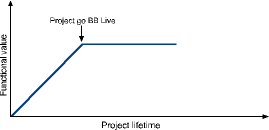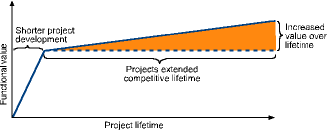
Invensys’ new ArchestrA industrial application architecture extends the useful life of existing plant systems and lowers the total cost of ownership by enabling disparate solutions to work in concert like the instruments of an orchestra.
Quality, responsiveness and cost efficiency have always been imperative for the survival of any plant or factory, but never more so than today. As the pace of change accelerates at Internet warp speed, product cycles are growing shorter and more complex. New or enhanced products must be brought to market far more quickly or they risk being obsolete. These same products must also be rapidly customisable for use in any global market - which means that manufacturers must be extremely agile if they are to survive in today's economically efficient markets.
At the same time, there are new market drivers that complicate the issue. Application integration costs keep rising while manpower shortages in engineering fields mean that there are fewer people to do the work. In addition, the total cost of ownership is more critical than ever because manufacturers need to squeeze as much production as possible from their lines and to extend the lives of those lines for as long as possible. Information management is more critical than ever because users want centralised client/server systems that operate similarly to their enterprise applications, but the realities of the factory environment require peer-to-peer systems for linking thousands of plant floor devices.
What do these issues mean for plant and factory managers as they evaluate options for meeting these challenges? They can look to better automation and information solutions, but many plants and factories have already invested millions in technology without being able to quantify the results. The solution is to deploy production systems that can increase the productivity of existing production investments as well as provide long-term expansion capabilities - but that is easier said than done. Up till now, it has been difficult to engineer automation and information systems that deliver finished projects in much shorter timeframes and with custom-tailored functionality for different users than with conventional approaches. In order to be viable over the long term, such systems would also have to take advantage of the latest developments in software, applications and services so as to allow the use of modular, re-usable component objects that are applicable across multiple automation and information applications - this would eliminate the need for the continual, costly, time-consuming and error-prone recreation of functionality.
Recognising that a totally new solution was needed, Invensys spent the past four years developing just such a powerful architecture for industrial applications. This new architecture is called ArchestrA - a combination of the words architecture and orchestra - and it comes to market as a unique combination of new toolsets, new products, new applications and new services. ArchestrA is a comprehensive software architecture that brings powerful new benefits to industrial automation/information users - from OEMs to system integrators (SIs) and end-users.
New business model
Products and services that make use of Architecture By ArchestrA offer a new business model for manufacturers. The architecture enables the re-use of engineering from project to project for shorter automation and information project development time. This reduces the total cost of ownership of automation applications because it facilitates easy upgrades, thereby extending project lifecycles. By enabling the integration of existing production systems and new applications ArchestrA extends the useful life of production lines as well as that of entire plants.
In the past, application developers have created each automation solution from scratch (see Figure 1). They took time to develop the functionality needed to produce particular goods and, once the project went 'live', it had a finite lifecycle. In most cases, the competitiveness of the application degraded over time and new projects had to be created for new products.

Today, using the ArchestrA approach, project lifecycles can be extended virtually indefinitely (see Figure 2). Because of the common infrastructure elements provided with ArchestrA, it is easier to shorten the project development timeframe through the re-use of engineering from earlier projects. It is also easier to upgrade and enhance existing production facilities because of the universal nature of the ArchestrA architecture. This leads to an increase in the value of the original production application and a lengthening of its competitive lifetime.

Engineering costs represent about 60% of the typical automation project, with the hardware used to implement it accounting for 25% of the project cost and the application software being responsible for the remaining 15%. A major benefit of using products and services based on the ArchestrA architecture is that they reduce total project cost by reducing the engineering time/cost component of projects. This is done by increasing engineering efficiency, enhancing team collaboration and lengthening the long-term productive life of the application.
With ArchestrA, as much as 70% of project engineering can be re-used. This means that there is reduced development overhead and better utilisation of scarce engineering resources. There is a corresponding reduction in site commissioning costs which results in reduced deployment time and less project risk.
Perhaps the greatest benefit of this new architecture is that, for the first time, it enables application developers to concentrate on making the best use of their domain expertise rather than spending time and effort on the underlying integration 'plumbing'. They no longer need to concern themselves with operating system issues or application infrastructure issues, which are resolved by the underlying architecture. They can simply focus on their specific domain expertise to make sure the application is all that it can be and that end-user needs are satisfied.
New approach to industrial software
The ArchestrA architecture can provide these unprecedented benefits because it incorporates all of the primary software services that are needed to build industrial automation applications. It insulates users from the complexities of the underlying networking hardware and operating system technologies so that they only need assembly skills rather than sophisticated programming skills. They can now concentrate on their application domain requirements, with which they are already familiar, because common application requirements already form part of the ArchestrA software infrastructure. This solution is available to both OEMs and end-users because the ArchestrA architecture resided on top of foundation technologies provided by Microsoft with its operating system, database, web services, communications and associated enabling software. Developers simply assemble application objects using ArchestrA toolkits and the resulting solutions can be re-used in subsequent generations of applications as well as in complementary applications.
ArchestrA was designed specifically to provide an architecture with common technology that is deployed in all automation/information applications. These software services include:
* A new application design and modelling environment that can encapsulate existing plant applications as well as provide the foundation for new ones.
* Software toolkits that provide centralised configuration of all aspects of an application, from deployment services to version change control and built-in administration facilities.
* Powerful scripting and calculation facilities for easy customisation of applications to meet particular domain requirements.
* Distributed alarm and event subsystems that provide consistency across multiple application sources.
* Powerful history logging facilities for the collection of factory data, alarms and events from any source as well as for viewing and accessing data as one application entity.
* Built-in distributed architecture for unlimited scalability but with single name space capability for centralised management and maintenance.
* Peer-to-peer integration of all types of plant and field devices and networks.
* Simplified version management for easier extension of production project efficiency over the lifetime of a plant.
* Flexible role-based security model based on Microsoft Windows standard.
* Remote system diagnostics and system administration functions for easier management of day-to-day operations.
* Easy internationalisation of objects and application services for deploying applications at plants anywhere in the world.
* Common graphical user interface for viewing applications from any device, from plant floor workstation to web browsers, PDAs, PCs and other terminals.
Taken together, all of these ArchestrA architectural capabilities create a new business model that abstracts the development of plant-wide automation applications from their deployment while bringing new cost efficiency to production systems. ArchestrA is the foundation software architecture that will power the next generations of Invesys' leading plant automation and information offerings and it is uniquely being made available through OEMs and SIs. The groundbreaking new technology, applications and services provided by the ArchestrA architecture marks the start of a new era of productivity and profitability for the industrial automation and information marketplaces.

For more information contact Mike le Plastrier, Futuristix Advanced Control Systems, 011 723 9900, [email protected], www.futuristix.co.za

© Technews Publishing (Pty) Ltd | All Rights Reserved